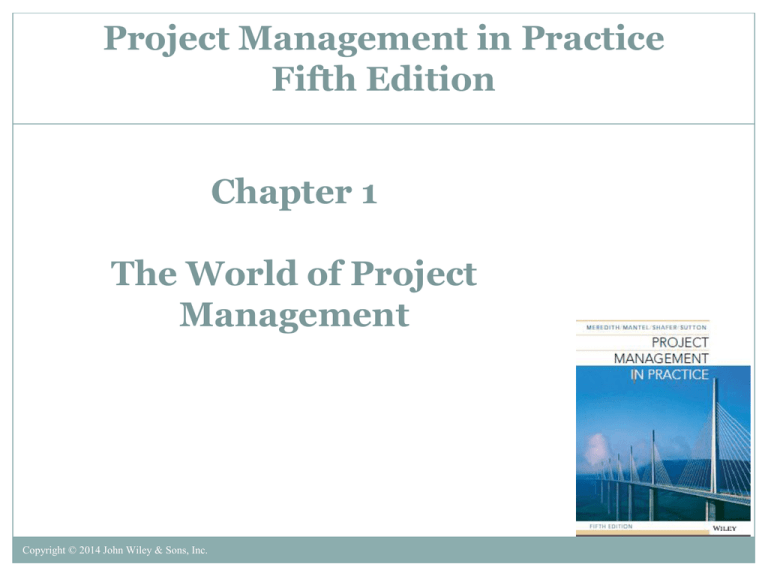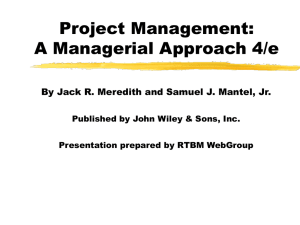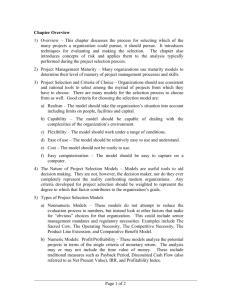
Project Management in Practice
Fifth Edition
Chapter 1
The World of Project
Management
Copyright © 2014 John Wiley & Sons, Inc.
Why the Emphasis on Project
Management?
• Many tasks do not fit neatly into businessas-usual
• Organizations need to assign responsibility
and authority for the achievement of their
goals
1-2
Characteristics of Projects
• Unique
• Specific deliverables
• Specific due date
1-3
Formal Definition of a Project
“A project is a temporary endeavor
undertaken to create a unique product or
service.”
Project Management Institute, 2007
1-4
Formal Definition of Project
Management
“The application of knowledge, skills, tools,
and techniques to a broad range of activities in
order to meet the requirements of a particular
project.”
Project Management Institute, 2007
1-5
Other Common Characteristics of
Projects
•
•
•
•
Multidisciplinary
Complex
Often involve conflicts
Part of programs
1-6
Trends in Project Management
•
•
•
•
•
Achieving strategic goals
Achieving routine goals
Improving project effectiveness
Virtual projects
Quasi-projects
1-7
Comparison of Project Management
and General Management
Table 1-1
1-8
Project Budgets
• Project budgeting differs from standard budgeting
in the way budgets are constructed
• Budgets for non-projects are primarily
modifications of budgets for the same activity in
the previous period
• Project budgets are newly created for each project
and often cover several “budget periods” in the
future
1-9
Project Schedules
• In manufacturing, the sequence of activities
is set when production line designed
– Sequence is not altered when new models are
produced
• Each project has a schedule of its own
– Previous projects with deliverables similar to
current one may provide a rough template
– However, specifics unique to project at hand
1-10
Project Organizational Structure
• Routine work of organizations takes place within a
well-defined structure
– The divisions, departments, sections, and similar
subdivisions of the total unit
• Typical project cannot thrive in this structure
• The need for technical knowledge, information,
and special skills requires that departmental lines
be crossed
– Another way of describing the multidisciplinary
character of projects
1-11
Globalization
• When large firms establish manufacturing plants
or distribution centers in different countries, a
management team is established on site
• For projects, globalization has a different meaning
• Members of project teams may be spread across
countries and speak different languages
• Some project team members may never have a
face-to-face meeting
1-12
Negotiation
• With little authority, the project manager
depends on negotiation skills to gain the
cooperation of departments in the
organization
• Those departments have their own
objectives, priorities, and personnel
• The project is not their responsibility and
the project tends to get the leftovers
1-13
Three Different Types of
Negotiation
1. Win-win
2. Win-lose
3. Lose-lose
1-14
Three Goals of Project Management
1. Scope
2. Cost
3. Time
1-15
Scope, Cost, and Time
Project Performance Targets
Figure 1-1
1-16
Uncertainty
• All projects are always carried out under
conditions of uncertainty
– Projects are all about uncertainty
• Effective project management requires an ability
to deal with uncertainty
• Projects are complex and include interfaces,
interdependencies, and assumptions, which may
turn out to be wrong
– People add to the uncertainty
1-17
Uncertainties Encountered in Project
Management
• Time required to complete a project
• Availability and cost of key resources
• Timing of solutions to technological
problems
• Macroeconomic variables
• The whims of clients
• Actions taken by competitors
1-18
Can Uncertainty be Eliminated?
• No, uncertainty cannot be eliminated
• However, if managed properly, it can be
minimized
1-19
Managing Risk
• The first step in managing risk is to identify
potentially uncertain events and likelihood of
occurrence
– Called risk analysis
• Different organizations approach this differently
• The essence of risk analysis is to make
assumptions about key risk parameters and to use
models to evaluate the desirability of certain
managerial decisions
1-20
Fourth Project Goal
• There is a relationship between uncertainty
and the three traditional project goals
• Therefore, we adopt the view in this book
that managing uncertainty is a fourth goal of
project management
• Thus, the primary role of the project
manager is to effectively manage the tradeoffs between cost, time, scope, and risk
1-21
Abilities Needed For Effective
Project Management
•
•
•
•
•
Ability to resolve conflicts
Creativity and flexibility
Ability to adjust to change
Good planning skills
Negotiation skills
1-22
The Life Cycle of Projects
• All organisms have a life cycle, they are born,
grow, wane, and die
– So do projects
• Some projects follow an S-shaped curve
– They start slowly, develop momentum, and then finish
slowly
• Other project follow a J-shaped curve
– They start slowly , proceed slowly, and then finish
rapidly
1-23
The Project Life Cycle
Figure 1-2
1-24
An Alternate Project Life Cycle
Figure 1-3
1-25
Selecting Projects To Meet
Organizational Objectives
• Project selection is process of evaluating projects
and choosing them so firm objectives are met
• Ensure that several conditions are considered
1.
2.
3.
4.
Is the project potentially profitable?
Is the project required
Does firm have the skills to complete the project
Does the project involve building strategic
competencies
5. Does it have capacity to carry out the project
6. Can project be economically successful
1-26
Selection Methods
•
•
There are many different methods for
selecting projects
They may be grouped into two
fundamental types
1. Nonnumeric: does not use numbers for
evaluation
2. Numeric: uses numbers for evaluation
1-27
Nonnumeric Selection Methods
• The Sacred Cow: a pet project advocated by a
senior executive of the firm.
• The operating/competitive necessity
• Comparative benefits
– Rank-ordering a small number of projects is not
difficult
– When the number of projects exceeds 15 or 20, the
difficulty of ordering the group rises rapidly
– A Q-sort is a convenient way to handle the task
1-28
The Q-sort Method
Figure 1-4
1-29
Numeric Selection Methods
•
Financial assessment methods
1. Payback period
2. Discounted cash flow
3. Future opportunity analysis
•
Scoring methods
1. Unweighted 0-1 factor method
2. Weighted factor scoring method
1-30
Payback Period
Initial Fixed Investment
Annual Net Cash Inflows
1-31
Discounted Cash Flow
n
Ft
NPV (project) - I 0
t
t 1 (1 k )
where
I0 = The initial investment
Ft = The net cash flow in period t
k = The required rate of return or hurdle rate
1-32
The Weighted Scoring Model
n
Si sij w j
j 1
where
Si = The total score of the ith project
sij = The score of the ith project on the jth criterion
wj = The weight or importance of the jth criterion
1-33
Steps in the Project Portfolio Process
1.
2.
3.
4.
5.
6.
7.
Establish a project council
Identify project categories and criteria
Collect project data
Assess resource availability
Reduce the project and criteria set
Prioritize the projects within categories
Select the projects to be funded and those to be
held in reserve
8. Implement the process
1-34
Categories of Projects
• Derivative projects: those that are only
incrementally different from existing offerings
• Platform projects: major departures from existing
offerings
– The next generation
• Breakthrough projects: involving a newer
technology
– Possibly a “disruptive” technology
• R&D projects: “blue sky” or visionary endeavors
1-35
The Materials in This Text
• Chapter 2 focuses on the behavioral and structural
aspects of projects and their management
• Chapter 3 covers the process of planning and
launching the project, construction of the WBS,
and responsibility charts
• Chapter 4 discusses the construction of a project
budget and presents a method of improving one’s
estimating skills
1-36
The Materials in This Text Continued
• Chapter 5 covers scheduling, PERT, CPM,
and Gantt charts
• Chapter 6 covers resource allocation
• Chapter 7 covers monitoring and controlling
projects
• Chapter 8 deals with evaluating, auditing,
and terminating projects
1-37
Copyright
Copyright © 2014 John Wiley & Sons, Inc.
All rights reserved. Reproduction or translation of this work
beyond that permitted in Section 117 of the 1976 United
States Copyright Act without express permission of the
copyright owner is unlawful. Request for further information
should be addressed to the Permissions Department, John
Wiley & Sons, Inc. The purchaser may make back-up copies
for his/her own use only and not for distribution or resale.
The Publisher assumes no responsibility for errors, omissions,
or damages, caused by the use of these programs or from the
use of the information herein.
1-38










